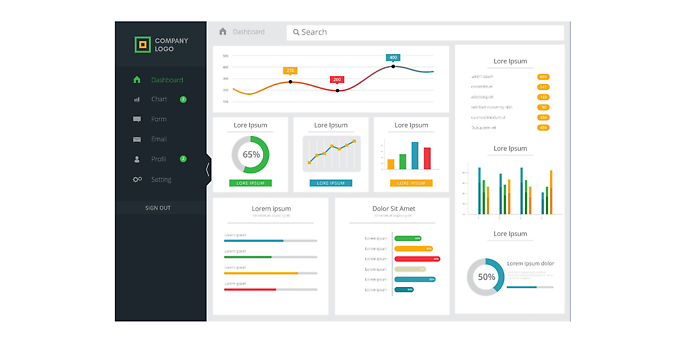13. July 2023 By Wolfgang Weber and Andreas Essl
Key performance indicators and dashboards are a key internal management tool for revenue optimisation for grid operators
The energy transition means a lot of volatility in many sectors of the economy. One of the sectors most affected by this is the energy industry, with the impact being felt most by electricity and gas grid operators. Historically, the energy industry has been a rather stable business with relatively steady KPIs. Now, increasingly, it is subject to volatility and large shifts in these figures.
Reports and KPIs create transparency that is of great help for many departments at a company. When the business environment changes, this shows up immediately in regular, partially automated analyses, allowing companies to adapt quickly and at low cost to new conditions.
Using dashboards is recommended since they are a cost-effective tool for grid operators in view of the limited budgets available to them. In addition, better cost control can lead to higher revenue at regulated grid operators.
A dashboard is a graphical user interface used to visualise and prepare data. The main advantage of dashboards is that all relevant KPIs can be seen at a glance and accessed in just a few clicks. Dashboards can typically be customised for different user groups with different requirements and information needs. This can even be done by the individual users to cater their specific needs (self-service reporting).
Key elements of a dashboard:
- 1. Data sources: Dashboards draw data from various sources, including sensors, measuring devices, and monitoring and grid control systems. Data is captured in real time and subsequently transmitted to the dashboard in near real-time. Data for business dashboards can be sourced from ERP systems.
- 2. Data visualisation: Dashboards present the collected data in a visually appealing way. They use charts, graphs, maps and other visualisation techniques to display KPIs. In some cases, just the figures themselves are shown.
- 3. Real-time monitoring and oversight: Dashboards enable real-time monitoring of a grid, for example. Operators can track important parameters such as voltage, current, generation (electricity) or pressure (gas/water) and utilisation of a grid in real time, allowing them to identify and rectify potential problems early on.
- 4. Alarms and notifications: Users can set up alarms and notifications in dashboards to inform operators of deviations from specific parameters, alert them to critical events or send a message if a certain value exceeds or falls below a defined threshold. This allows them to response quickly to disruptions and abnormalities.
Why use dashboards?
The number of measurable parameters and KPIs is growing by the day at work, both on the technical front as well as on the business and regulatory side. Many of the figures and key performance indicators (KPIs) are subject to wild swings and provide a lot of important information, especially in relation to the financial situation of the company.
In addition, if dashboards were not used, many of these figures and numbers would be buried away deep inside an ERP or some other system, for example. In some cases, data has to be (manually) collected and analysed several times across multiple systems in order to obtain or generate the up-to-date KPIs that are needed.
Dashboards are a better way to do this because users can access data with maximum ease. Ideally, this is done right in the browser to make sure users are not reluctant to use the dashboard. They do not have to login again and they always use the most up-to-date information.
In addition, a large amount of information can be displayed on dashboards because the data is presented in graphs and charts. Users can quickly see multiple, related contexts at a glance.
The main advantages of dashboards:
- Creates transparency (if necessary for a wide group of users)
- Easy and intuitive to use
- No separate login to systems necessary (in most cases)
- Little to no special knowledge is required to use the data management systems
- Every user knows where to find the latest, most important key figures/KPIs
- Displays a lot of information in a small amount of space
Key requirements
Needless to say, a dashboard can only access the data if it is also maintained in data fields in systems.
That is why it is important that...
- the necessary data and/or source data are already available in a system;
- the data and/or source data are regularly and consistently updated either automatically or manually (invoice postings, for example) in the system; and
- the data management system can make the data available to a dashboard via an interface.

Es gibt viele grafische Visualisierungsmöglichkeiten von Kennzahlen und Dashboards, Quelle: Image by pikisuperstar on Freepik
Selecting the key figures
When it comes to selecting key figures, it is important to find the right balance. If there are too many of them, documentation, data collection, evaluation, analysis, presentation and interpretation, as well as making the necessary decisions, will take too long. On the other hand, if too few are available, it would not be possible to make informed decisions.
It is also important to note is that the KPI value in itself only provides a limited amount of information. For most quantitative KPIs, an additional (qualitative) interpretation, such as text, is useful and necessary. Otherwise, they can lead to false conclusions and poor decisions in the second and third management tier above the operational unit. Furthermore, it is very important to find and display the ‘right’ KPIs for the relevant management parameter. To minimise the chances of the KPI being misinterpreted, the parameter, the unit and the formula underlying it should be easy to understand.
Benchmarking individual indicators and comparing them with those from similar grid operators in the industry can be helpful in strategic planning. Due primarily to costs and depreciation, regulated distribution system operators often have medium- and long-term options to optimise their operations that can often only be achieved using KPIs. With respect to grid controlling as well as new concepts such as process mining, robot process automation (RPA) and artificial intelligence (AI), it is important to analyse which processes can be improved and optimised and which KPIs can be used for this purpose.
The incentive-based regulation mechanism is an enticement for German regulated distribution grid operators to continuously reduce costs, with internal KPIs being the tool of choice across all management levels to lower costs. Accurate and correct KPIs are a solid foundation and the basis for internal performance management.
Information design
After you have chosen the correct KPIs, you should also think about how to present and visualise them. This process is referred to as information design.
International Business Communication Standards (IBCS) has developed seven scientifically based success rules for this purpose that serve as the basis for how to optimally structure a report or dashboard. The seven rules go under the acronym ‘SUCCESS’:
- 1. Say: Get the message across by describing, explaining and recommending. This requires a clear understanding of the target group and the recipients as well as the key messages.
- 2. Unify: The same content is presented in the same way, while different content may not be displayed in the same way.
- 3. Condense: Increase information density in order to more effectively present complex issues.
- 4. Check: Ensure visual integrity.
- 5. Express: Find suitable visualisation elements and efficient message delivery.
- 6. Structure: Organise the report by following the prescribed structures and using consistent elements.
- 7. Simplify: Eliminate redundancies to improve understanding.
The advantages of such an approach include rapid recognition of content, correct interpretation through functional pattern recognition and targeted use of colours for special events to immediately capture important information.
Focus on business KPIs from the ERP system using embedded analytics
In our blog post, we will be focusing on dashboards containing financial and business KPIs for grid operators, since the ERP system, as the single source of data, streamlines and lowers the cost of displaying these figures in dashboards.
In step one, we recommend that you visualise KPIs on the basis of the most recent real data from the ERP system by means of embedded analytics . In embedded analytics, reports, KPIs and dashboards are displayed in the data source system. Key performance indicators are shown in near real time as well. This means that the underlying figures in the embedded analytics dashboard are quickly adapted to come in line with the values in the fields in the ERP system. One of the main advantages of embedded analytics is that expensive database systems (data warehouses with data replication) are not needed and do not have to be set up and maintained. Conversely, one of the downsides is that other technologies that are somewhat more complex are better suited for the visualisation of historical (legacy) data and forecast data.
At a later stage, technical KPIs from other systems (including GIS systems and grid calculation software) can be added, if necessary in additional dashboards. These can also be combined with financial and technical KPIs, such as the costs per grid level. Due to the slightly more complicated requirements, it generally makes sense to use a data warehouse or a data platform here.
As a general rule, business KPIs have proved highly valuable for regulated grid operators:
- Actual investments from the current business plan year versus planned/target values (budget) in euros
- Actual expenses from the current business plan year versus planned/target values (budget) in euros
In most cases, it makes sense to break down these financial KPIs, for example, by:
- line of business (electricity, gas, water, heat, telecommunications, services, etc.);
- grid or voltage level/pressure level;
- pipelines and installations; or
- internal and third-party services.
Thanks to the high level of transparency achieved with these KPIs, deviations are spotted quickly if the figures are regularly monitored. In that way, the employees concerned can react quickly during the year instead of receiving an unpleasant surprise at the end of the year, which would leave them little scope to respond.
In addition, the traditional information chain that runs through controlling (and, where applicable, management) to the operational units – in relation to the business plan, this would typically be the asset service – can be significantly shortened. That is because the units can regularly call up the most current KPIs on a dashboard and take action in response much more quickly.
Business decision-makers in lower and middle management also need significantly more information in their dashboard. For top management, a highly aggregated view with high information density – i.e., a management cockpit – can answer this need.
Examples of other KPIs for the dashboard include:
Financial KPIs such as values for medium-term planning, in-house and third-party services in per cent as well as personnel costs in euros.
- Regulatory KPIs such as revenue ceiling, grid fees collected, lease fees, capital cost deduction/premium, regulatory account and income contributions in euros.
- Technical/business KPIs such as costs for maintenance, repairs, inspection per plant group and costs per kilometre of pipeline in euros.
- Rollout rates for smart metering systems in relation to the mandatory installation groups in per cent.
- The ‘smartification’ of the grid, such as:
- How many local substations are equipped with remotely monitored low-voltage feeders/how many are fitted with sensors on the medium-voltage side?
- How many short-circuit and earth leakage switches are remotely monitored?
- Proportion of levels that are remotely monitored in the water grid
What is needed to successfully implement practical and helpful dashboards at a grid operator? First and foremost, expert knowledge of the industry is needed, along with a precise definition of the KPIs and a user-friendly visualisation of the dashboard. These items can be discussed and jointly decided on in well-established workshop formats. A balanced mix of internal specialists and outside experts who contribute best practices from the industry and knowledge about visualisation has proven successful.
Conclusion
As long as the necessary data is available in a system that is easy to connect to, a dashboard is a simple and highly useful tool to present the KPIs and charts or graphs needed for management purposes to a user group. As a general rule, dashboards are intuitive to use, and users do not need to log in or have knowledge of the system.
Data from the ERP system is well suited for a dashboard when you first get started. Why? Because this data source is a low-cost way to provide information used in important KPIs and dashboards (for example, by means of embedded analytics) that are able to offer significant added value, especially when it comes time to carrying out the business plan.
Under the incentive-based regulation, for example, it is very important that operating expenses (OPEX) in various cost categories remain within a narrow band and that the planned values are therefore maintained to the maximum extent possible. If operational staff regularly check the dashboards, they can easily spot deviations early on and taken action in response at several levels within the company. If no dashboards are available to them, many things would be spotted too late, not leaving enough time to react to them and bring about the changes in behaviour necessary to achieve the desired results or to reach the (budget) targets. Because they are so intuitive, dashboards can reduce any inhibitions users may have about using them. Along with that, they make it fun to analyse the data and make the changes necessary as part of the energy transition.
You will find more exciting content from the adesso world in our latest blog posts.
Why not check out some of our other interesting blog posts?


